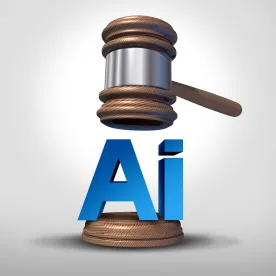Generative AI is becoming increasingly popular across various industries due to its ability to improve efficiency and creativity. Specifically, companies can use AI to generate marketing materials, social media posts, product design, and more. However, while AI-generated content offers numerous benefits, it also comes with potential copyright risks that companies should understand before using such content. This alert highlights the three most important copyright considerations.
First, the U.S. Copyright Office (USCO) will not register AI-generated content due to the absence of a human author.
This means that enforcement against unauthorized copying or use of AI-generated works will be difficult because you cannot sue based on copyright infringement without a federal copyright registration.
The USCO recently issued a Statement of Policy outlining this position. In short, works containing AI-generated content will be assessed on a case-by-case basis. If the output is simply a mechanical reproduction of the human’s input, like photographs taken with a camera, it may be registrable. But where AI determines the expressive elements of output, it will not be registrable. If a work contains both AI-generated content and human-created content, the human elements may be registrable if they separately meet the requirements for copyright protection — but any AI-generated content must be disclaimed.
The case of Thaler v. Perlmutter, et al. is challenging this position.[i] Thaler, a computer scientist, applied to register a copyright for a work of visual art titled A Recent Entrance to Paradise. Thaler’s AI, the Creativity Machine, generated the artwork and its title. The USCO refused Thaler’s application on the basis that copyright law does not protect non-human creators, citing U.S. Supreme Court precedent, statutory text, and USCO practice.
After a three-person USCO appeals board sustained the refusal, Thaler appealed. The parties have filed cross motions for summary judgment. In our judgment, there is good reason to believe the D.C. federal court will ultimately side with the USCO given the deference courts give to USCO decisions. Notably, a decision in support of the USCO would be consistent with prior case law involving Thaler in which the Federal Circuit Court of Appeals refused to permit AI to be an “inventor” for patent purposes on an analogous basis.[ii]
Second, use of third-party copyrighted materials to train AI may violate that third party's copyright.
There are at least two ongoing cases that are testing this claim. Specifically, Getty Images is suing Stability AI for copyright infringement based on its use of Getty’s images to train its AI.[iii] Several artists have also filed a class action lawsuit against Stability AI, Midjourney, and DeviantArt with a similar claim that using their copyright-protected works to train the AI constituted copyright infringement.[iv] Both of these cases are in early stages and are worth following.
In addition, the USCO launched an initiative to assess how the law should apply to the use of copyrighted works in AI training and the resulting outputs. It will seek public input on these issues later this year.[v]
Third, AI-generated output may infringe third-party rights and create confusion as to ownership.
Specifically, AI is trained on input data, and at present, may not be able to moderate its output to ensure it doesn’t violate third-party rights. This creates an inherent risk that AI could wrongfully include a third party's intellectual property in its output.
Third-party AI platform terms can also further complicate this.[vi] For example, while a platform can assign all rights that it has in its output to the user, such rights may be minimal if it incorporates content owned by third parties into the output. Or, if the AI platform generates the same or substantially similar output to two or more users, it could be “assigning” the same IP to multiple users. This is further (or less) complicated by the fact that, as noted above, AI output is not currently copyrightable.
In light of these risks, companies using generative AI should:
- Wherever possible, impose contractual terms against those accessing or using AI-generated content (e.g., website terms of use) that prohibit unauthorized copying and use of AI-generated content and otherwise shift risk. In such cases, if there is no copyright claim, there may be a breach of contract claim.
- Add human contributions to any AI-generated content before using it. If the human contributions meet the requisite level of creativity for copyright protection, that will increase the chances of obtaining a registration, and companies can enforce their rights in at least the human-created portions. Further, adding significant contributions could potentially reduce the similarity to any previous third-party content that may have been incorporated into the AI-generated output.
[i] Case No. 1:22-cv-01564.
[ii] See Thaler v. Vidal, 43 F.4th 1207 (Fed. Cir. 2022).
[iii] Getty Images (US), Inc. v. Stability AI, Inc., Case No. 1:23-cv-00135.
[iv] Andersen et al v. Stability AI Ltd. et al, Case No. 3:23-cv-00201.
[v] https://www.copyright.gov/
[vi] While this alert focuses on copyright issues, relevant third-party platform terms should generally be reviewed in full before using them for business purposes. For example, the terms could restrict use of the platform or its output for business purposes. And, if the relevant platform can unilaterally update its terms at any time, in a perfect (though likely unrealistic) world, such terms should be reviewed immediately prior to each use.



 />i
/>i
